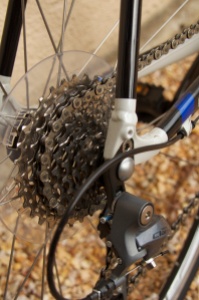San Francisco-Stanford Commuting
 I’ve now been commuting from San Francisco to Stanford for nearly four weeks and thought it might be helpful to pen some observations for folks who are considering living in SF, but working in Palo Alto or at Stanford (at each of the postdoc activities I’ve attended, we’ve been reminded there are more than 2,300 of us campus-wide at a time, so I think there’s an audience for this). Prior to moving here, I tried to research the viability of the commute and how it would work with biking, but found the level of detail lacking on posts at Quora and elsewhere. In sum, it’s entirely doable with bikes and haven’t gotten too exhausted by it yet.
I’ve now been commuting from San Francisco to Stanford for nearly four weeks and thought it might be helpful to pen some observations for folks who are considering living in SF, but working in Palo Alto or at Stanford (at each of the postdoc activities I’ve attended, we’ve been reminded there are more than 2,300 of us campus-wide at a time, so I think there’s an audience for this). Prior to moving here, I tried to research the viability of the commute and how it would work with biking, but found the level of detail lacking on posts at Quora and elsewhere. In sum, it’s entirely doable with bikes and haven’t gotten too exhausted by it yet.
My preferred commute consists of a couple separate legs. First, I have an SF-based bike that I ride from my apartment in SoMa to the 4th and King Street Caltrain station. This is about 6 minutes, and there’s a bike path the entire length of Townsend Street. I then leave this bike at the staffed Bike Station parking facility, which remains open until 8:30PM. Parking there is free through the first night, but subsequent nights are charged at $5 each. The Bike Station also can repair your bike while you’re at work, and they have a small shop with some basic accessories like fenders, tubes, and tires for sale. An alternative to parking here would be renting out a Caltrain bike locker, but currently all 180 lockers are rented out.
On the Palo Alto side, I keep a bike parked overnight at the Bikestation which operates a large room accessible by keyless fob on the Southbound side of the train station. There’s a sufficient number of racks and security so far seems to be quite good (i.e., make sure no one follows you into the room without using their fob). You can get 12-months of parking access for slightly more than $100, though some people have suffered bad experiences with inadequate reminder notices informing them of impending contract expiration, and have been locked out for several days on end despite renewing. This leg, from Palo Alto station to Stanford office bike rack, takes about 8 minutes and involves only 3 major intersections where you could potentially be delayed.
For several weeks I did the standard haul-your-bike-on-the-train routine, park it in one of two bike cars (if you’re riding the Baby Bullet), and hopefully find a nearby seat. I never got bumped from a train because of too few rack spaces available, but you will spend a decent amount of time organizing your bike, moving it around, loading and unloading off the train, and waiting for others. Since there’s a sizable crowd traveling from 4th/King to Palo Alto, you can usually find a stack of bikes heading to your destination, so there’s no need to reorganize to ensure the nearest bike belongs to the first person disembarking.
A major downside to this commute is that a lot of folks are relatively clueless or indifferent about how they treat other peoples’ bikes (and even their own), so doing this day in day out is likely to cause some spokes to get pulled and for your derailleurs to get caught up in another bike’s components. Better to bring a junker, even at the risk of your cyclist cred being compromised. Your chances of finding both a seat and a spot to place your bike are obviously increasing in trains traveling at off-peak hours, but given that conductors usually turn a blind eye to 5 and maybe even 6 bikes on a stack (when 4 is Caltrain’s official maximum), you needn’t worry about finding a space on the morning southbound if you’re boarding at 4th/King. There is a second wave of cyclists on-boarding at 22nd in Dogpatch, and they inevitably have a tougher time finding space and organizing their bikes, especially those who are heading further south than Mountain View. So far, I haven’t seen those folks turned away either, but it may be happening on earlier trains than mine.
In total, the door-to-door trip is slightly less than an hour and ten minutes, in large part from living within a few blocks of the SF station. I’d say the absolute commute minimum would be living at Avalon, skipping the SF bike portion, and simply walking to the morning train. Alternatively, Potrero Hill may be an option for you because of its proximity to the 22nd Street station, but the hilliness is hit-or-miss and what appears to be close could be quite a time-consuming walk or ride. Overall, the availability of amenities and density of grocery stores, restaurants, retail is also substantially higher in SoMa, providing more reasons to opt for this part of town where there’s simply more going on, at both higher cost and more limited green spaces.